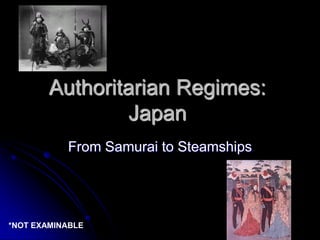
Meiji Restoration
- 1. Authoritarian Regimes: Japan From Samurai to Steamships *NOT EXAMINABLE
- 2. Japan: Some key facts Known as Nippon (Land of the Rising Sun) 4 Major islands (Honshu, Kyushu, Hokkaido & Shikoku) Shinto Religion: Emperor divine, descendant of Sun Goddess Majority of population peasants
- 3. Tokugawa Shogunate (1603-1868) Japan ruled by Emperor (religious) & Shogun (military) Samurai as lords & nobles Hermit kingdom – closed its doors to the world Homogeneous language & culture The Samurai were not as chivalrous as popular culture today depicts them to be.
- 4. East Meets West 1853 – Arrival of Commodore Perry Japan thrown into turmoil Shogunate discredited – signed unfavourable treaties Dissidents wanted to topple the Shogun and restore power to Emperor In 1868, the Meiji Emperor ascended the throne of Japan, & a new era of modernisation began. Japanese depiction of Perry’s arrival. The Japanese had no answer to the American cannons.
- 5. Meiji Restoration Meiji leaders understood that in order to save Japan from being colonised & to be accepted by the west, they had to modernise. Leaders were all young, western educated & idealistic Impressed by the power of the west & felt Japan could follow suit “Rich Country, Strong Military” The Meiji emperor reigned from 1868-1912. He was 15 when he ascended the throne.
- 6. “Knowledge shall be sought throughout the world so as to strengthen the foundations of imperial rule. . . Evil customs of the past shall be broken off and everything based on the just laws of nature.” Meiji Charter Oath – 1868
- 7. Meiji Reforms - Political Constitution based on German model Constitutional monarchy – cult of Emperor established Parliament or Diet established Power centralised – no more domains The Meiji Oligarchy or Genro
- 8. Meiji Reforms - Military Abolition of Samurai class Introduction of conscript army – Blood tax New army put down Satsuma Rebellion Disgruntled Samurai rose up against the new conscript army: Swords vs. Guns, the outcome was predictable…
- 9. Meiji Reforms - Economic Massive industrialisation – Textiles as Japan’s no.1 export. Rise of Zaibatsu Land reforms to help peasants grow more crops Mitsubishi didn’t just manufacture cars and fridges in those days
- 10. Meiji Reforms - Social Education encouraged – pple taught to embrace modernity & revere Emperor. Foreign talent – about 5000 by 1880 The Japanese people were encouraged to embrace modern changes.
- 11. A Meiji era factory – women were encouraged to work as well.
- 12. Meiji Reforms – Report Card Victories in Sino-Japanese War, 1894, Russo-Japanese War, 1905 & WW I, 1918 Strong industrial base Modern infrastructure, economy and army By Meiji Emperor’s death in 1912, Japan was considered the major power in the Far East The world sat up and took notice as Japan became the first Asian nation to defeat a European nation in war.
- 13. In 20 years, Japan went from… This To this!